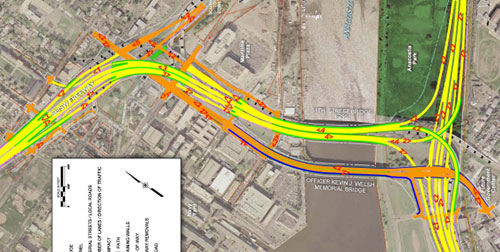11th Street bridges design makes some improvements
JDLand got a copy of the current design for the 11th Street bridges project. The original EIS showed a potential layout for the ramps and bridges, but DDOT asked engineering firms bidding on the project to design their own implementations.
The winning proposal, from Skanska/Facchina, would improve on the original design in a few ways. It places the two bridges (highway and local) closer together, shrinking the overall footprint of the project. It also lowers some ramps on the Anacostia side, allowing trees to obscure the view of the ramps from Ridge Place and other residential streets. And the firm claims that they can build 75% of the project without disrupting the existing traffic flow, by building new segments and ramps next to or around existing ones.
According to DDOT Director Gabe Klein, DDOT was able to mix and match some features from various proposals. It’s not clear whether this is the blended design or just S/F’s original suggestion. A few potential improvements jump out. Southbound on the local bridge, the original EIS showed a fairly sharp right turn to Good Hope Road and the freeway. S/F, instead, places a gentler turning ramp to Good Hope while keeping a sharp turn to the freeway. They have space to do that because they’ve moved the local bridge closer to the freeway bridge. However, it would be even better to just keep the sharper turn, allowing for even more space in Anacostia Park uninterrupted by freeway ramps. The sharper turn would also encourage lower speeds on the local bridge, which is not supposed to be for high-speed traffic and will accommodate pedestrians, bicycles and potentially streetcars.
The freeway bridge seems to have two ramps exiting as drivers reach capitol hill heading northbound. The original EIS only showed one, to M Street I can’t figure out why there are two here. These ramps seem to also spread more widely away from the freeway. That might be an effort to build more of the project without disrupting the existing project. However, if the ramps hugged the freeway more closely, that would leave land along 12th Street that could one day be developed. Similarly, from the drawing it appears they are moving 12th Street over a little bit. If so, it’s not clear why.
JD also notices that some of the ramps are missing in the drawing; according to a commenter, DC only has $230 million of the $360 for the full project, and has bid out the first portion to start.
Update: kk points out that the current ramps let drivers use either the local or freeway bridges to cross the river from Capitol Hill and access 295. In fact, if the freeway bridge gets backed up, it appears to be very easy for drivers to get off 295, take the local bridge, and then hop back on the freeway at the other end. The purpose of the local bridge is to accommodate traffic between the neighborhoods on either end, not to function as even more lanes for through traffic or to be a very expensive, very long off-ramp from the freeway to Capitol Hill.
Perhaps the interchange with the Anacostia Freeway should prevent cars from getting off the freeway and turning onto the bridge, or entering the freeway from the bridge. If drivers on the Capitol Hill side want to get on the freeway, they should get on the freeway side of the bridge instead. Doing this would also simplify the intersection where C-1, C-2 and C-4 all meet. Plus, this could allow narrower ramps, which might save money that DC could use to pay for the rest of the project.


